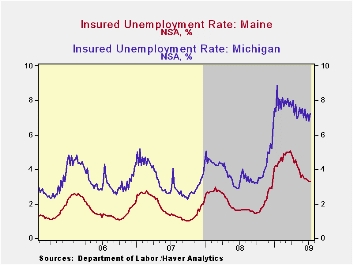 Global| Jul 30 2009
Global| Jul 30 2009U.S. Weekly Claims For Jobless Insurance Rise, But Falling Trend Suggests Improved Labor Market
by:Tom Moeller
|in:Economy in Brief
Summary
The rate of improvement in the job market again appears to have slowed. The latest figures from the Labor Department indicate that initial claims rose for the second consecutive week after sharp declines early in the month. The latest [...]

The rate of improvement in the job market again appears to have slowed. The latest figures from the Labor Department indicate that initial claims rose for the second consecutive week after sharp declines early in the month. The latest increase to 584,000 from an upwardly revised level during the prior period returned claims to near where they started July. Nevertheless, so far this month the 559,000 average level of claims is down from the 616,000 averaged during June and from the March high of 674,000. The four-week average of claims, which smoothes out some of the volatility in the weekly numbers, fell to 559,000 which was its lowest level since late-January. Claims of 580,000 had been expected during the latest week.
The Labor Department indicated that the largest increases in initial claims for the week ending July 18 were in California (+4,290, 41.1% y/y), Michigan (+3,654, 21.0% y/y), Florida (+3,291, 41.2% y/y), Connecticut (+749, 79.1% y/y), and Indiana (+526, -0.7% y/y)), while the largest decreases were in New York (-22,052, 46.2% y/y), Wisconsin (-6,791, 5.5% y/y), Missouri (-6,529, 63.1% y/y), Pennsylvania (-6,420, 60.2% y/y), and Ohio (-5,062, 28.5% y/y).
The rate of labor market improvement may have slowed, but a trend improvement in conditions is clearly evident from the decline in continuing claims for unemployment insurance. They fell a modest 54,000 last week after a similar decline during the prior week. However, the average this month is down sharply from June and the weekly figure is the lowest since mid-April. The continuing claims figures lag initial claims by one week and provide an indication of workers' ability to find employment. Despite the latest decline, however, the level of 6,197,000 claims still up sharply from the year ago level. The four-week average of continuing claims fell back to 6,416,250 which was the lowest since mid-May. The series dates back to 1966.
The insured rate of unemployment remained at 4.7% which was the lowest level since mid-April. During the last ten years, there has been a 93% correlation between the level of the insured unemployment rate and the overall rate of unemployment published by the Bureau of Labor Statistics.
The highest insured unemployment rates in the week ending July 11 were in Puerto Rico (7.3 percent), Michigan (7.2), Oregon (6.7), Pennsylvania (6.4), Nevada (6.2), Wisconsin (6.1), Connecticut (5.6), New Jersey (5.6), Arkansas (5.5), California (5.5), North Carolina (5.5), and South Carolina (5.5). The lowest rates were in Wyoming (3.0), Texas (3.1), Maine (3.3), Colorado (3.4), Maryland (3.6), Minnesota (3.9), Florida (4.4), Mississippi (4.4) and Georgia (4.6).
The unemployment insurance claims data is available in Haver's WEEKLY database and the state data is in the REGIONW database
The Fed's latest Beige Book covering regional economic conditions can be found here.
| Unemployment Insurance (000s) | 07/25/09 | 07/18/09 | 07/11/09 | Y/Y | 2008 | 2007 | 2006 |
|---|---|---|---|---|---|---|---|
| Initial Claims | 584 | 559 | 524 | 32.1% | 420 | 321 | 313 |
| Continuing Claims | -- | 6,197 | 6,251 | 87.3% | 3,342 | 2,552 | 2,459 |
| Insured Unemployment Rate (%) | 4.7 | 4.7 | 2.4 | 2.5 | 1.9 | 1.9 |
Tom Moeller
AuthorMore in Author Profile »Prior to joining Haver Analytics in 2000, Mr. Moeller worked as the Economist at Chancellor Capital Management from 1985 to 1999. There, he developed comprehensive economic forecasts and interpreted economic data for equity and fixed income portfolio managers. Also at Chancellor, Mr. Moeller worked as an equity analyst and was responsible for researching and rating companies in the economically sensitive automobile and housing industries for investment in Chancellor’s equity portfolio. Prior to joining Chancellor, Mr. Moeller was an Economist at Citibank from 1979 to 1984. He also analyzed pricing behavior in the metals industry for the Council on Wage and Price Stability in Washington, D.C. In 1999, Mr. Moeller received the award for most accurate forecast from the Forecasters' Club of New York. From 1990 to 1992 he was President of the New York Association for Business Economists. Mr. Moeller earned an M.B.A. in Finance from Fordham University, where he graduated in 1987. He holds a Bachelor of Arts in Economics from George Washington University.






